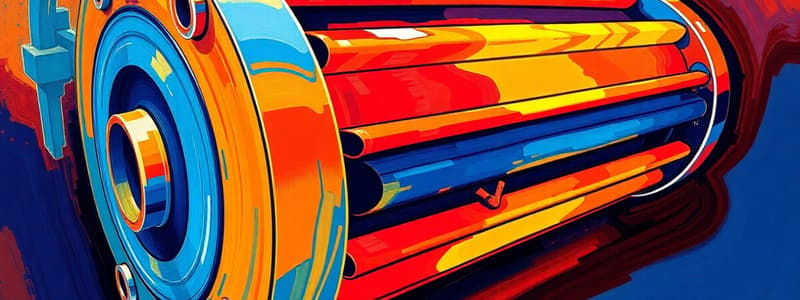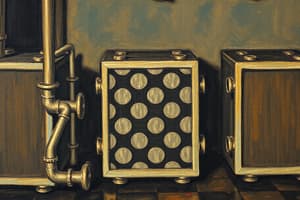Podcast
Questions and Answers
What is the primary function of a heat exchanger?
What is the primary function of a heat exchanger?
To allow two materials to exchange heat without coming into contact with each other.
Describe the role of the tube wall in a shell and tube exchanger.
Describe the role of the tube wall in a shell and tube exchanger.
The tube wall conducts heat from the warmer fluid to the cooler fluid passing outside the tubes.
What is E-100 and what is its specific application?
What is E-100 and what is its specific application?
E-100 is a multi-tube, U-type heat exchanger that superheats pipeline ethylene using 100 psig steam.
What is the purpose of the D-110 Charge Gas Compressor Suction Drum?
What is the purpose of the D-110 Charge Gas Compressor Suction Drum?
What are demister pads, and where are they used in the D-110?
What are demister pads, and where are they used in the D-110?
Flashcards are hidden until you start studying
Study Notes
Heat Exchanger Overview
- Heat exchangers facilitate heat transfer between two materials without direct contact, typically through conduction.
- Hot fluid transfers heat to cooler fluid, resulting in increased temperature for the cooler fluid and decreased temperature for the warmer fluid.
- Separation of fluids is achieved using metal tubes, with one stream flowing inside the tubes and the other outside.
- Heat transfer occurs as fluids move and contact the metal tubes.
Shell and Tube Exchanger
- Comprised of hollow cylindrical vessels called shells containing bundles of tubes.
- One fluid circulates through the shell while another flows through the tubes, allowing effective heat exchange.
- Cooler fluid increases in temperature while warmer fluid decreases, optimizing the heating and cooling process.
- Traditionally used for cooling products before transport, now also utilized for heat integration to preheat incoming streams.
E-100 (Ethylene Preheater)
- Multi-tube, U-type heat exchanger designed specifically for heating pipeline ethylene.
- Operates with 100 psig steam on the shell side to superheat ethylene before the next stage of processing.
- Enhances energy efficiency and process effectiveness by preheating the ethylene.
D-110 (Charge Gas Compressor Suction Drum)
- Dimensions: 5’6” diameter x 9’ length, serving both Charge Gas Compressors (C-120A/B).
- Incorporated with internal demister pads below top vapor outlets to eliminate liquid entrainment in ethylene streams.
- Pipeline and recycle ethylene enter from the side; heavier components (C4+) are expelled from the bottom while vapor ethylene exits from the top.
Heat Exchanger Overview
- Heat exchangers transfer heat between two fluids without direct contact, using conduction.
- The hot fluid transfers heat to the cooler fluid through metal tubes, which separate the two streams.
- Designs vary, but all heat exchangers aim to heat one stream while cooling another, excluding cooling towers which operate differently.
Shell and Tube Exchanger
- Consists of cylindrical vessels (called shells) containing tube bundles for fluid flow.
- One product flows through the shell, while another flows through the tubes, facilitating heat exchange via metal walls.
- Utilized to cool products before shipment, increasingly repurposed for heat integration due to rising energy costs.
E-100 (Ethylene Preheater)
- A multi-tube, U-type heat exchanger specifically designed for heating pipeline ethylene.
- Operates with ethylene on the tube side and 100 psig steam on the shell side.
- Installed to superheat ethylene before the next processing stage.
D-110 (Charge Gas Compressor Suction Drum)
- Dimensions: 5’6” diameter and 9’ length.
- Serves both C-120A/B Charge Gas Compressors, enhancing efficiency and functionality.
- Equipped with internal demister pads to eliminate liquid entrainment in the ethylene streams.
- Receives pipeline and recycled ethylene streams; heavier components (C4+) exit from the bottom, while vapor ethylene exits from the top.
Studying That Suits You
Use AI to generate personalized quizzes and flashcards to suit your learning preferences.



